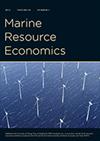对虾养殖中的疾病对野生捕获虾的影响
IF 1.7
3区 经济学
Q2 ECONOMICS
引用次数: 9
摘要
我们利用墨西哥湾的价格和从厄瓜多尔、泰国和印度尼西亚进口的美国对虾,调查了由疾病引起的对虾养殖供应冲击是否会增加美国墨西哥湾野生捕获虾的价格。许多研究表明,虾市场是协整的,这意味着相对价格往往不会出现实质性或长期的差异。我们还发现了协整关系,并评估了结构断裂的向量误差校正模型,以确定价格关系中最显著的变化是否与水产养殖疾病危机的时间一致。由于对虾养殖的创新,海湾地区的价格在整个21世纪初稳步下降,然而,从2011年左右开始,早期死亡综合征(EMS)对水产养殖造成了重大干扰。我们的研究结果表明,EMS可能对我们的价格长期关系造成了干扰,这表明疾病可能为美国对虾渔业带来了暂时的好处。本文章由计算机程序翻译,如有差异,请以英文原文为准。
Implications of Disease in Shrimp Aquaculture for Wild-Caught Shrimp
We investigate whether supply shocks in shrimp aquaculture caused by disease increase prices of wild-caught shrimp in the US Gulf of Mexico, using Gulf prices and US shrimp imports from Ecuador, Thailand, and Indonesia. Many studies have shown that shrimp markets are cointegrated, meaning relative prices tend not to diverge substantially or for long periods. We also find cointegration, and we evaluate a vector error correction model for structural breaks to determine whether the most significant changes in the price relationships coincide with the timing of disease crises in aquaculture. Gulf prices fell steadily throughout the early 2000s because of innovations in shrimp aquaculture, however, early mortality syndrome (EMS) caused a major disruption in aquaculture starting around 2011. Our results indicate that EMS may have precipitated a disturbance to the long-run relationship of our prices, suggesting that disease may have offered temporary benefits to the US shrimp fishery.
求助全文
通过发布文献求助,成功后即可免费获取论文全文。
去求助
来源期刊

Marine Resource Economics
农林科学-渔业
CiteScore
4.30
自引率
10.30%
发文量
25
审稿时长
>12 weeks
期刊介绍:
Marine Resource Economics (MRE) publishes creative and scholarly economic analyses of a range of issues related to natural resource use in the global marine environment. The scope of the journal includes conceptual and empirical investigations aimed at addressing real-world oceans and coastal policy problems. Examples include studies of fisheries, aquaculture, seafood marketing and trade, marine biodiversity, marine and coastal recreation, marine pollution, offshore oil and gas, seabed mining, renewable ocean energy sources, marine transportation, coastal land use and climate adaptation, and management of estuaries and watersheds.
 求助内容:
求助内容: 应助结果提醒方式:
应助结果提醒方式:


